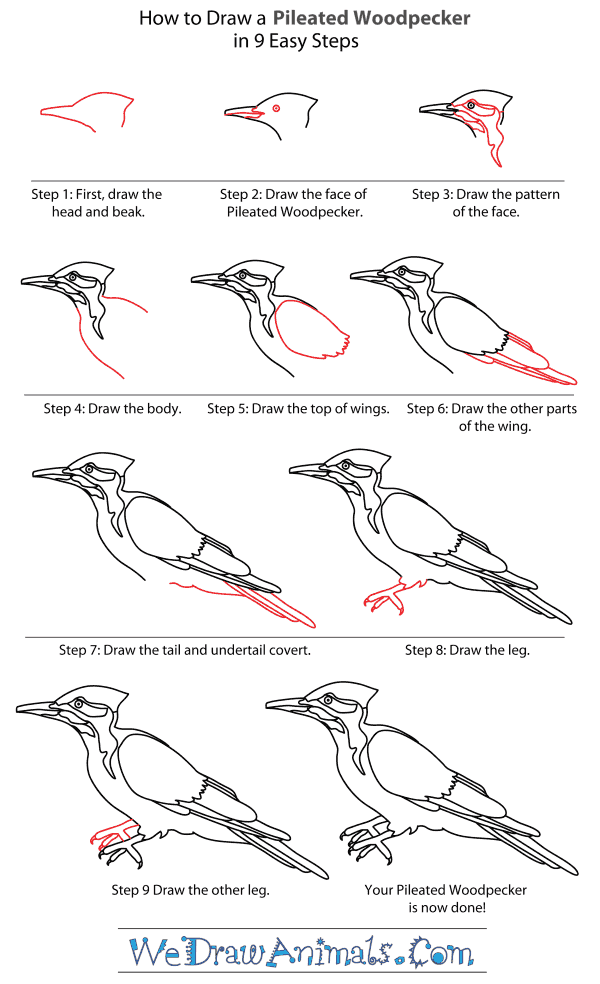In this quick tutorial you'll learn how to draw a Pileated Woodpecker in 9 easy steps - great for kids and novice artists.
The images above represent how your finished drawing is going to look and the steps involved.
Below are the individual steps - you can click on each one for a High Resolution printable PDF version.
At the bottom you can read some interesting facts about the Pileated Woodpecker.
Make sure you also check out any of the hundreds of drawing tutorials grouped by category.
How to Draw a Pileated Woodpecker - Step-by-Step Tutorial
Step 1: The first step when drawing your Pileated Woodpecker, you will need to draw the head. To draw the head, draw an arced line for the head with a triangle shape for the beak.
Step 2: Next you will need to draw the face. Start by drawing a circle with a smaller circle inside for the eye. Draw a straight line through the beak.
Step 3: For the pattern of the face you will want to draw curved lines, that break apart the face as shown above.
Step 4: Now you will need to draw the body. To draw the body, draw a curved line coming out of the bottom of the head and one coming from the top of the head.
Step 5: To draw the top part of the wing draw a large semi circle with a jagged line connecting the two points.
Step 6: The next step is to draw the other parts of the wing by drawing increasingly longer semi circles inside each other until it extends past the body.
Step 7: Now draw the tail and under tail covert. To do this, draw three elongated semi circles next to each other coming out of the back of the body. Draw a jagged line from the tail to the foot for the under tail.
Step 8: Step 8 is to draw the woodpecker's leg. Draw the leg with three elongated semi circles for toes.
Step 9: The final step is to draw the other foot behind the first in the same way you drew the first one. You now have drawn a Pileated Woodpecker.
Interesting Facts about the PILEATED WOODPECKER
The Pileated Woodpecker is a member of the bird family and the scientific term for them is Dryocopus pileatus. Another common name for this animal is the Jungle Bird, since it has an echoing laugh that permeates the forest. This is the largest type of this species in North America. They hit the side of trees with their beak, which may sound like a hammer hitting a hard surface.
Did you know?
- The animal was first documented in 1758.
- This species is over 1.5 feet in length.
- They have wingspan of over 2.5 feet.
- The bird weighs almost 1 pound.
- They make nests about 15 feet from the ground.
- The bird has each wing at almost 1 foot wide.
- They have a tail more than .5 feet long.
- The creature has a beak almost 1/4 of a foot long.
They’re black with a white stipe on its sides and a red crested head. Most of their diet consists of insects, especially carpenter ants and beetle worms. Fruit, nuts, and berries, even berries from Poison Ivy, are eaten. There are not many of these creatures, but they’re the least concern for a possibility of extinction.










